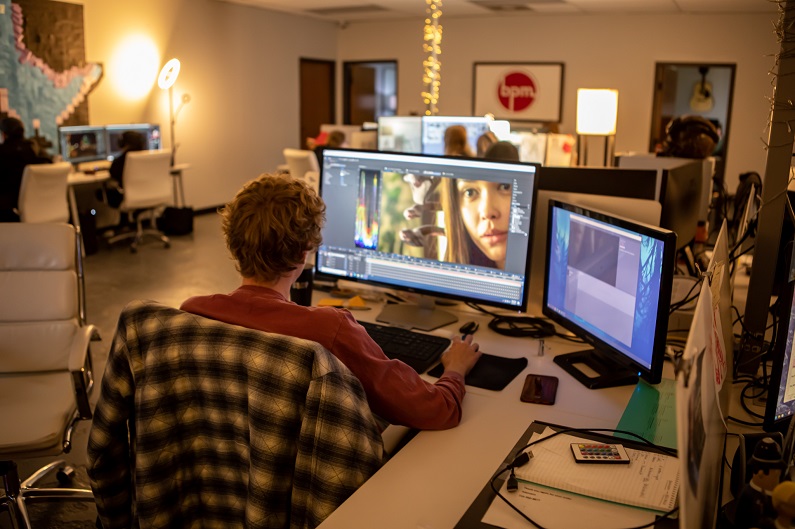- A film colorist works with the director of photography to create and implement a projects color palette including color intensity, luminance levels and chroma.
- Different types of color grading include analogous, moody, and vintage.
- Boiling Point Media has trained, knowledgeable, and experienced film colorist available for work.
What defines a film? Is it the plot, the director, or the actors? Films and TV shows cannot be defined without the overall tone and mood set by the production’s film colorist. Film colorists are also known as Color Graders and Post Digital Imaging Technicians. Not only do film colorists contribute to the look and feel of a film by defining its colors, but it’s their job to perfect the way in which color is applied to the images presented, this is also known as grading.
What Is A Film Colorist
Working with the director and director of photography, film colorists work to decide the palette, the intensity of the color, what selection of colors to use, and to develop certain looks by adjusting the luminance levels and chroma. They are also responsible for ensuring the film complies with the law around luminance levels and chroma. Productions are typically shot on digital film in a raw format. Color is not seen until it is manually applied because the information about the color is captured in the data. Colorists will receive the files from the film and then meet with both the director and director of photography, to capture their vision as they apply the color. Time is patiently spent matching up the pictures shots as they balance the color saturation and luminance, to make sure the particular shot conveys the intended emotion in the sequence. Elaborate tool set equips film colorist with the ability to offer creative solutions to picture-related issues. This includes images that were under or over and provide day or night corrections. The ability to do this is called Color Grading and the mail goal is to evoke a certain mood and to achieve a certain style.
Types of Color Grading
Color Grading can be accomplished by applying a certain color scheme to a sequence or shot by a film colorist. This post production process adjusts color to create more interesting and stylized images. Film colorists have been known to use lab film tints and distinctive filters to change the color scheme. There are several types of color grading used by film colorists. A few of the most common styles include analogous grading, moody color grading, and vintage color grading. Part of the colorists job is understanding the whole process, making sure they are equipped with the proper knowledge to navigate certain softwares to perform their task.
Analogous Color Grading
Analogous color grading is typically used in nature and landscape videos by applying the colors next to each other on the color wheel.
Moody Color Grading
Moody color grading applies cool colors to create a sense of intrigue and mystery. This is best for scenes with shadows or dim lighting, colorists only adjust the contrast for effect.
Vintage Color Grading
Vintage color grading creates a retro look to depict a sense of nostalgia from the audience, most commonly used in flashback scenes, this is set by toning down the contrast levels and highlighting warm colors.
Types Of Tasks A Film Colorist Performs
Film Colorists must adapt to using different editing software. Popular software applications that are used include DaVinci Studios and Baseline. A good film colorist must be able have a high attention to detail to ensure their best work. Another skill a film colorist should have is a stong knowledge in the understanding of color and especially how to use different colors to enhance a story. The right colors used will have a psychological effect on the film viewer and needs to fit the style of the film production. Communication is one of the most important tasks of a film colorist. This includes working well with the director and director of photography as they work through and share their work in the post production process. To work as a film colorist, other important tasks and abilities are to be patient, work with the changes in the color and picture, and continue to pay attention to detail when under pressure.
What Qualifications Does A Film Colorist Need
There are different ways to become a colorist. Commonly, film colorists start out as a post production edit or tech assistant or a runner in the film industry. This helps gain access to more knowledge in the post production process for several years. A university degree in art and design, photography, graphic design or communications, physics, psychology, or computing science are helpful degrees. Vocational qualifications are also an option like NCFE Applied General Certificate in Art and Design, BTEC National Diploma/Extended Diploma in Art and Design, or the BTEC National Extended Diploma in Creative Digitcal Media Production. There are also options to go straight into a film colorist job or apprenticeship. Building proper portfolios in order to learn more about editing styles and impressing others in the film industry as well as looking for post production companies are two of many qualifications that can help equip the proper tool set.
Film Colorist At Boiling Point Media
Film Colorists are essential to the filmmaking process and can make or break any film. The team of film colorists at Boiling Point Media understand this and keep this in mind as we add color to the film projects we work on. Our Emmy Award winning team will transform your raw production footage into the film masterpiece that you are envisioning. Film coloring is one of the post production filmmaking services we provide. Check out our website to see our filmography of films we have created or worked on. Are you producing a film? Give Boiling Point Media a call and see how we can take your film to its boiling point!
